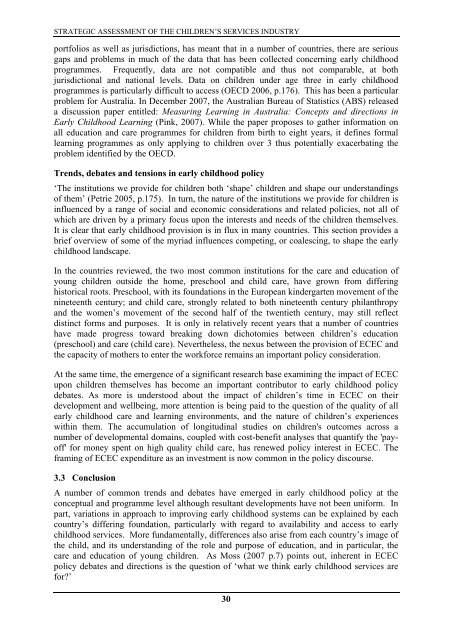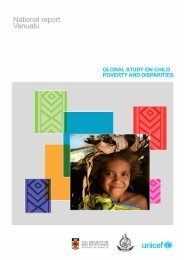A Strategic Assessment of the Children's Services Industry
A Strategic Assessment of the Children's Services Industry
A Strategic Assessment of the Children's Services Industry
- No tags were found...
Create successful ePaper yourself
Turn your PDF publications into a flip-book with our unique Google optimized e-Paper software.
STRATEGIC ASSESSMENT OF THE CHILDREN’S SERVICES INDUSTRYportfolios as well as jurisdictions, has meant that in a number <strong>of</strong> countries, <strong>the</strong>re are seriousgaps and problems in much <strong>of</strong> <strong>the</strong> data that has been collected concerning early childhoodprogrammes. Frequently, data are not compatible and thus not comparable, at bothjurisdictional and national levels. Data on children under age three in early childhoodprogrammes is particularly difficult to access (OECD 2006, p.176). This has been a particularproblem for Australia. In December 2007, <strong>the</strong> Australian Bureau <strong>of</strong> Statistics (ABS) releaseda discussion paper entitled: Measuring Learning in Australia: Concepts and directions inEarly Childhood Learning (Pink, 2007). While <strong>the</strong> paper proposes to ga<strong>the</strong>r information onall education and care programmes for children from birth to eight years, it defines formallearning programmes as only applying to children over 3 thus potentially exacerbating <strong>the</strong>problem identified by <strong>the</strong> OECD.Trends, debates and tensions in early childhood policy‘The institutions we provide for children both ‘shape’ children and shape our understandings<strong>of</strong> <strong>the</strong>m’ (Petrie 2005, p.175). In turn, <strong>the</strong> nature <strong>of</strong> <strong>the</strong> institutions we provide for children isinfluenced by a range <strong>of</strong> social and economic considerations and related policies, not all <strong>of</strong>which are driven by a primary focus upon <strong>the</strong> interests and needs <strong>of</strong> <strong>the</strong> children <strong>the</strong>mselves.It is clear that early childhood provision is in flux in many countries. This section provides abrief overview <strong>of</strong> some <strong>of</strong> <strong>the</strong> myriad influences competing, or coalescing, to shape <strong>the</strong> earlychildhood landscape.In <strong>the</strong> countries reviewed, <strong>the</strong> two most common institutions for <strong>the</strong> care and education <strong>of</strong>young children outside <strong>the</strong> home, preschool and child care, have grown from differinghistorical roots. Preschool, with its foundations in <strong>the</strong> European kindergarten movement <strong>of</strong> <strong>the</strong>nineteenth century; and child care, strongly related to both nineteenth century philanthropyand <strong>the</strong> women’s movement <strong>of</strong> <strong>the</strong> second half <strong>of</strong> <strong>the</strong> twentieth century, may still reflectdistinct forms and purposes. It is only in relatively recent years that a number <strong>of</strong> countrieshave made progress toward breaking down dichotomies between children’s education(preschool) and care (child care). Never<strong>the</strong>less, <strong>the</strong> nexus between <strong>the</strong> provision <strong>of</strong> ECEC and<strong>the</strong> capacity <strong>of</strong> mo<strong>the</strong>rs to enter <strong>the</strong> workforce remains an important policy consideration.At <strong>the</strong> same time, <strong>the</strong> emergence <strong>of</strong> a significant research base examining <strong>the</strong> impact <strong>of</strong> ECECupon children <strong>the</strong>mselves has become an important contributor to early childhood policydebates. As more is understood about <strong>the</strong> impact <strong>of</strong> children’s time in ECEC on <strong>the</strong>irdevelopment and wellbeing, more attention is being paid to <strong>the</strong> question <strong>of</strong> <strong>the</strong> quality <strong>of</strong> allearly childhood care and learning environments, and <strong>the</strong> nature <strong>of</strong> children’s experienceswithin <strong>the</strong>m. The accumulation <strong>of</strong> longitudinal studies on children's outcomes across anumber <strong>of</strong> developmental domains, coupled with cost-benefit analyses that quantify <strong>the</strong> 'pay<strong>of</strong>f'for money spent on high quality child care, has renewed policy interest in ECEC. Theframing <strong>of</strong> ECEC expenditure as an investment is now common in <strong>the</strong> policy discourse.3.3 ConclusionA number <strong>of</strong> common trends and debates have emerged in early childhood policy at <strong>the</strong>conceptual and programme level although resultant developments have not been uniform. Inpart, variations in approach to improving early childhood systems can be explained by eachcountry’s differing foundation, particularly with regard to availability and access to earlychildhood services. More fundamentally, differences also arise from each country’s image <strong>of</strong><strong>the</strong> child, and its understanding <strong>of</strong> <strong>the</strong> role and purpose <strong>of</strong> education, and in particular, <strong>the</strong>care and education <strong>of</strong> young children. As Moss (2007 p.7) points out, inherent in ECECpolicy debates and directions is <strong>the</strong> question <strong>of</strong> ‘what we think early childhood services arefor?’30
















